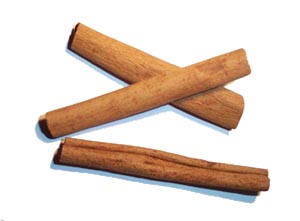Cinnamon
Cinnamon is a spice from the inner bark of Cinnamomum verum.
| Cinnamon | |
|---|---|

| |
| Cinnamon foliage and flowers | |
| Scientific classification | |
| Kingdom: | |
| Division: | |
| Class: | |
| Order: | |
| Family: | |
| Genus: | |
| Binomial name | |
| Cinnamomum verum | |
The spice is used in both sweet and savoury foods. It is aromatic. People usually put cinnamon in sweet baked goods (such as cinnamon rolls), hot wine or liquors.
Cinnamon was used to make the spiced wine, claret, in the Middle Ages. In India, cinnamon is commonly used in making flavoured tea. It is either directly added as small pieces or put in powdered form during the preparation of tea. It is known as "Daal-Cheeni (दाल चीनि)" in Hindi.
The Sinhalese name of cinnamon is kurundu. Cinnamon is grown as an export crop in Sri Lanka.
Cinnamon as a herbal remedy
There is a literature which suggests that cinnamon spice may have positive effects on diabetes type II.[1][2][3][4][5] This is not the view of the U.S., National Institutes of Health.[6]
Cinnamon Media
Dried bark strips, bark powder and flowers of the small tree Cinnamomum verum
Cinnamomum verum, from Koehler's Medicinal-Plants (1887)
Uncooked cinnamon rolls
Quills of Ceylon cinnamon (Cinnamomum verum, left) and Indonesian cinnamon (C. burmanni, right)
References
- ↑ Khan A. et al 2003. Cinnamon improves glucose and lipids of people with type 2 diabetes. Diabetes Care. 26 (12) 3215-8.
- ↑ Mang B. et al 2006. Effects of a cinnamon extract on plasma glucose, HbA, and serum lipids in diabetes mellitus type 2. Eur J Clin Invest. 36 (5) 340-4.
- ↑ Kirkham S. et al 2009. The potential of cinnamon to reduce blood glucose levels in patients with type 2 diabetes and insulin resistance. Diabetes Obes Metab. 11 (12) 1100-13.
- ↑ Hlebowicz J. et al 2007. Effect of cinnamon on postprandial blood glucose, gastric emptying, and satiety in healthy subjects. Am J Clin Nutr. 85 1552-6.
- ↑ Jarvill-Taylor K.J. et al 2001. A hydroxychalcone derived from cinnamon functions as a mimetic for insulin in 3T3-L1 adipocytes. J Am Coll Nutr. 20 (4) 327-336.
- ↑ National Center for Complementary and Alternative Medicine (NCCAM). Created: October 2011. Updated: April 2012 Herbs at a Glance: Cinnamon NCCAM Publication No. 463










